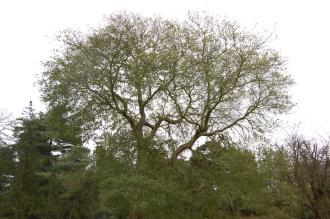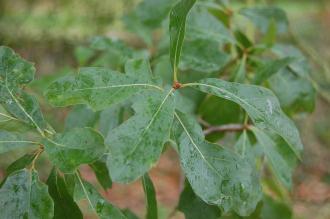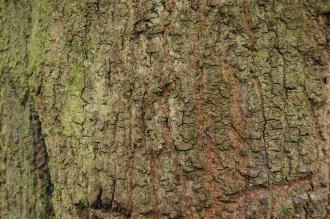
Quercus nigra (09/02/2013, Kew Gardens, London)
Position: Full sun
Flowering period: Early spring
Soil: Moist, well drained
Eventual Height: 20m
Eventual Spread: 20m
Hardiness: 6a – 10a
Family: Fagaceae
Quercus nigra is a fast growing, short lived semi-evergreen tree with a rounded, spreading habit. Its mid green leaves are spatula shaped with shallow lobes and entire margins, up to 12cm long and 6cm broad. Its branches. Its trunk may achieve a diameter of up to 1m. Its bark is smooth and brown when young, becoming rough with scaly ridges and grey/ black as the tree matures. Its monoecious flowers appear in the form of bright green male catkins and female flowers on the end of long stalks. Its flowers appear at the same time as the new leaves. Its fruit are acorns, arranged singularly or in pairs, up to 14mm long and 14mm broad.

Quercus nigra Leaf (09/02/2013, Kew Gardens, London)
Quercus nigra, commonly known as the Water Oak, Possum Oak or Spotted Oak, is native to south east USA. This tree is an effective pioneer species.
The etymological root of the binomial name Quercus is derived from the Latin name for an Oak tree, but some authorities believe it to be derived from the Celtic quer meaning ‘fine’ and cuez meaning ‘a tree’. Nigra is from the Latin meaning ‘black’.
The landscape architect may find Quercus nigra useful as a tree for planting in wet and marginal soils. It may be used as part of a native woodland mix in south east USA, performing the function of an effective nursery crop. This tree is attractive to deer.
Ecologically, Quercus nigra acorns are attractive to some birds and mammals.

Quercus nigra Bark (09/02/2013, Kew Gardens, London)
Quercus nigra prefers moist, fertile, well-drained soils. It tolerates most pH of soil. It will tolerate wet soils. It will also tolerate compacted soils.
Quercus nigra requires little maintenance.

